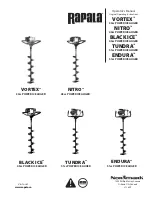
5
Ball Type Test Valves
Follow the requirements of each test when performed to ensure
successful installation, operation, and maintenance of the
backflow preventer.
Test No.1
Purpose:
To test check valve No. 2 for tightness against
reverse flow.
Requirements:
Valve must be tight against reverse flow under
all pressure differentials. Slowly open the ‘high’ valve A and the
‘vent’ valve C, and keep the ‘low’ valve B closed. Open test No.
4. Indicated pressure differential is expected to decrease slightly.
If pressure differential continues to decrease (until the vent
opens) check valve No. 2 is reported as ‘leaking.’
Test No. 2
Purpose:
To test shutoff No. 2 for tightness.
Requirements:
After passing test No. 1, continue to test No. 2
by closing test cock No. 2. The indicated pressure differential is
expected to decrease slightly. If pressure differential continues
to decrease (approaching ‘zero’), shutoff No. 2 is reported to be
‘leaking.’
Test No. 3
Purpose:
To test check valve No. 1 for tightness.
Requirements:
Valve must be tight against reverse flow under
all pressure differentials. Close ‘high’ valve A and open test cock
No. 2. Close test cock No. 4. Disconnect vent hose at test cock
No. 4. Open valves B and C, bleeding to atmosphere. Then
closing valve B restores the system to a normal static condition.
Observe the pressure differential gauge. If there is a decrease in
the indicated value, check valve No. 1 is reported as ‘leaking.’
Test No. 4
Purpose:
To test operation of pressure differential relief valve.
Requirements:
The pressure differential relief valve must
operate to maintain the ‘zone’ between the two check valves at
least 2 psi less than the supply pressure. Close ‘vent’ valve C.
Open ‘high’ valve A. Open the ‘low’ valve B very slowly until the
differential gauge needle starts to drop. Hold the valve at this
position and observe the gauge reading when the first discharge
is noted from the relief valve. Record this as the opening
differential pressure of the relief valve.
NOTICE
The differential gauge needle MUST drop slowly. Close test
cocks No. 2 and No. 3. Use the ‘vent’ hose to relieve pressure
from the test kit by opening valves A, B, and C. Remove all
test equipment and open shutoff No. 2.
CAUTION
!
To prevent freezing, hold Test Kit vertically to drain differential
gauge and hoses prior to placing in case.
Testing Reduced Pressure Zone Assemblies
(A)
(C)
High Hose
(Yellow)
Low Hose
(White or Red)
Vent Hose
(Blue)
Test Cock
No. 1
Test Cock
No. 2
Test Cock
No. 3
Test Cock
No. 4
(B)
Needle
Valve


























